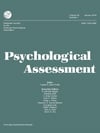An overarching 3-factor model was best supported through exploratory factor analysis, helping to clarify the underlying structure and utility of the CAPP-SR. This is the bottom line of a recently published article in Psychological Assessment. Below is a summary of the research and findings as well as a translation of this research into practice.

Featured Article | Psychological Assessment | 2021, Vol. 33, No. 10, 927-939
Factor Structure of the Comprehensive Assessment of Psychopathic Personality-Self-Report (CAPP-SR) in Community and Offender Samples
Authors
Martin Sellbom, University of Otago
Claire Liggins, University of Otago
Ilona Laurinaitytė, Vilnius University
David J. Cooke, University of Bergen
Abstract
The Comprehensive Assessment of Psychopathic Personality-Self-Report (CAPP-SR) is a recent operationalization of the CAPP model, which conceptualizes psychopathy in terms of 33 symptoms that can be thematically organized according to six theoretical domains. The current study examined the higher order factor structure of the CAPP-SR symptom scales in community, university, and offender samples derived from three separate countries. Exploratory factor analysis (EFA) indicated that a three-factor model (Antagonism/Meanness, Disinhibition, and Fearless Grandiosity) was optimal in a large population representative U.S. community sample. EFA with targeted rotation confirmed this three-factor structure in New Zealand university and Lithuanian prison samples. Furthermore, construct validity analyses against other psychopathy measures and psychopathy-relevant criteria provided initial support for the three CAPPSR latent factors. For instance, CAPP-SR Antagonism/Meanness was associated with other psychopathy scales reflective of antagonism, meanness, callous affect; CAPP-SR Disinhibition with other psychopathy scales reflective of behavioral psychopathy traits (e.g., impulsivity, irresponsibility), antisocial behavior, substance abuse; and CAPP-SR Fearless Grandiosity with narcissism, emotional stability, and boldness. These findings suggest that a three-factor structure provides for an alternative (to the traditional thematic domains) hierarchical interpretation of CAPP-SR scores.
Keywords
Comprehensive Assessment of Psychopathic Personality, psychopathy, self-report, factor analysis, construct validity
Summary of the Research
“The Comprehensive Assessment of Psychopathic Personality (CAPP) is one effort to integrate these multiple perspectives of PPD in a unified manner. It is a concept map designed to provide coverage of all aspects of PPD as identified in the theoretical, research, and clinical literatures. The developers adopted a bottom-up approach by seeking a comprehensive set of perspectives rather than being guided by one or a few conceptions of the construct. The CAPP was designed to be an over-inclusive concept map that would serve as a theoretical starting point to guide research designed to identify and clarify the core PPD symptoms as well as the development of a suite of novel measures of PPD” (p.927-928)
“The current study sought to evaluate the internal structure of the CAPP-SR symptom scales with an aim to provide an interpretable higher order factor structure to inform hierarchical interpretation. Given the lack of consistent guidance from the general literature, and the fact that none of the previous studies used the CAPP-SR, we took an exploratory approach, with a tentative expectation (given previous findings) that a three-factor solution would emerge. We conducted the primary exploratory factor analysis in a large community sample (N = 960) demographically representative of the United States population. We subsequently used the resulting structure and examined whether this factor structure would uphold in a large university sample from New Zealand as well as an offender sample from Lithuania, which (if consistent) would provide for both cross-national, cross-linguistic, and cross-setting confirmation of the structure.” (p.928)
“First, we conducted the EFA in the community sample. The parallel analysis indicated a 3-factor optimal solution…These loadings indicated that they reflected higher order concepts of Antagonism/Meanness (Factor 1), Disinhibition (Factor 2), and Fearless Grandiosity (Factor 3)… the first factor was deemed to reflect Antagonism/Meanness in light of the primary loadings of CAPP-SR scales such as Unempathic, Lacks Remorse, Uncommitted, Uncaring, and Lacks Emotional Depth, which come from the Attachment or Emotional domains and reflect deficiencies in the processing of emotions related to both intra- and interpersonal functioning. The Disinhibition label was supported by CAPP-SR scales such as Disruptive, Lacks Perseverance, Restless, and Lacks Emotional Stability, which represents various aspects of behavioral dyscontrol. Finally, Fearless Grandiosity was reflected in the loadings of scales such as Sense of Uniqueness, Lacks Anxiety, Domineering, Self-Aggrandizing, Sense of Uniqueness, and Sense of Entitlement” (p.932)
“..the CAPP-SR latent factors accounted for large proportions of variance in all of the psychopathy measures, across all three samples; moderate amounts of variance in externalizing criteria in the university sample; and large proportions of variance in the aggression variables in the offender sample.” (p. 934)
“…however, that the three-factor structure did not replicate as well in the prison sample, as it did in the other two samples. The Fearless Grandiosity factor replicated quite well, but the Antagonism/Meanness and Disinhibition factors were reflected in somewhat unexpected symptom patterns…For instance, Lacks Emotional Depth, Detached, and Self-Centered loaded on the Disinhibition factor, whereas Reckless and Disruptive loaded on the Antagonism/Meanness factor, which run counter to the other two samples, as well as conceptual expectations from the PPD literature more generally.” (p.936)
Translating Research into Practice
“The results suggest meaningful (albeit imperfect) pairings of conceptual CAPP domains with the Antagonism/Meanness factor capturing the essence of both the Attachment and Emotional domains; both domains concerned with affective, the former affect in regard to others, the latter affect more generally. The Disinhibition factor captures the essence of both the Behavioral and Cognitive domains, which are both concerned with behavioral regulation and adaptability. The Fearless Grandiosity factor captures the essence of the Dominance and Self domains; domains concerned with dysfunctional interpersonal agency and self-perception. Although the six CAPP domains continue to serve as a hierarchical interpretative framework, the current findings indicate that an even more reductionist approach might be useful for interpretation for research purposes; for clinical purposes a more nuanced approach may be beneficial” (p.937)
“The first factor was labeled Antagonism/Meanness, which we selected on the basis of the predominant symptom constellation and extant literature on this psychopathy construct. Many of the classic affective and disruptions in interpersonal affiliation symptoms loaded on this factor, including Unempathic, Lacks Remorse, Uncommitted, Uncaring, Lacks Emotional Depth, Intolerant, Manipulative, Deceitful, Detached, Aggressive, Antagonistic, and Self-Centered, but also Suspicious. These traits are similar to those observed on the classic “Factor 1” of the PCL-R, and even more specifically, the Deficient Affective Experience factor from Cooke and Michie’s (2001) three-factor PCL model. Moreover, the Antagonism/Meanness factor represents/captures/is consistent with the meanness domain in the contemporary triarchic psychopathy model (Patrick et al., 2009) and the antagonism domain in the EPA measurement framework. Indeed, the CAPP-SR Antagonism/Meanness factor scale was highly correlated with TriPM Meanness (rs = .80–.90), EPA-SF/SSF Antagonism (rs = .77–.88), and .52–.76 with other classic “Factor 1” measures and across samples.” (p.934)
“The second factor, labeled Disinhibition, clearly reflected the more behavioral, impulsive, and rule-breaking symptoms of PPD. Symptoms like Lacks Concentration, Lacks Perseverance, Restless, Lacks Emotional Stability, Self-Justifying, Reckless, and Lacks Planfulness all loaded on this factor. These traits reflect those on classic “Factor 2”, and specifically Cooke and Michie’s (2001) Impulsive and Irresponsible Behavioral Style factor, of PPD, as well as the construct of disinhibition that appears in the EPA measurement framework and the triarchic psychopathy model. Correlations with these various PPD measures, across samples ranged from .18 to .81. Surprisingly, the CAPP-SR Disinhibition factor did not show a significant association with TriPM Disinhibition (r = .18; β = .23) in the prison sample as was expected. Instead, a large correlation and contribution to the prediction of TriPM Disinhibition was associated with CAPP-SR Factor Antagonism/Meanness (r = .78; β = .79). This finding may be due to a variation in items loadings on to Factor 1 and Factor 2 in the prison compared to those in the community and university samples; with traditional ‘disinhibition’ symptoms such as Reckless, Lacks Concentration, Disruptive, Restless, and Lacks Emotional Stability, which show preferential Factor 2 loadings in the community and university samples, having meaningful loadings on either Factor 1 alone or both factors.” (p.934-935)
“The third factor, labeled Fearless Grandiosity, was conceptually somewhat more ambiguous than the other two factors, but also the one that clearly replicated the best across all three samples. It captured the fearless and dominance elements in the Psychopathic Personality Inventory and the triarchic psychopathy model construct of boldness because of loadings of CAPP-SR symptom scales, such as Lacks Anxiety, Domineering, Sense of Invulnerability, Sense of Uniqueness, but also a prominent negative loading of Lacks Pleasure. Correlations with TriPM Boldness supported this conclusion. Moreover, all of the grandiosity/narcissism symptoms on the CAPP also loaded on this factor; in addition to Sense of Uniqueness, also Self-Aggrandizing and Sense of Entitlement, Insincere, and Garrulous also loaded on this factor, which in combination covers the classic superficial charm/glibness feature of PPD. Indeed, in light of capturing elements of superficial charm, grandiosity, and also a secondary loading of CAPP-SR Manipulativeness on the Fearless Grandiosity factor, it aligns relatively well with the Deceitful Interpersonal Style factor from Cooke and Michie’s (2001) three-factor PCL model; the correlation with YPI-SF Interpersonal and SRP-4 Interpersonal Manipulation were .67 and .57, respectively. Finally, the Fearless Grandiosity factor can also be viewed as a combination of the emotional stability and narcissism factors observed in the EPA measurement framework as evident by the CAPP-SR factor scale’s correlations with EPA-SF/SSF Emotional Stability and Narcissism being of large magnitude (median r = .53).” (p.935-936)
“…the CAPP-SR Disinhibition factor scale, not unexpectedly, was associated with antisocial behavior, aggression, and alcohol and drug abuse to a more substantial degree than the other two factors, particularly when their overlap was considered in the multiple regression analyses. This is generally consistent with the psychopathy literature more generally that the behavioral psychopathy scales tend to be more strongly associated with externalizing than the affective and interpersonal scales. Only CAPP-SR Antagonism/Meanness, however, showed significant correlations with the OASys risk prediction measure in the offender sample; multiple regression model was not estimated for that criterion measure due to the limited sample size associated with this variable. Antagonism/Meanness was also the only factor to contribute to the prediction of the SRP-4 Criminal Tendencies scale.” (p.936)
Other Interesting Tidbits for Researchers and Clinicians
“…the three-factor structure observed here captures the broad domains observed in many other PPD models and should therefore also be directly familiar to most scholars and clinicians who are involved with PPD assessment. Should this three-factor structure continue to endure replication, particularly with other CAPP measures, such findings will contribute to the planned revision of the CAPP model based on all empirical data collected on the current model.” (p, 937)
“It will also be important to examine the clinical utility of these statistically-derived factor vis-à-vis the CAPP-SR domain scales. For instance, the CAPP model in particular is promoted as a dynamic risk tool as opposed to other psychopathy measures used in clinical settings (e.g., PCL-R), which are more static in nature, so it will be important to determine if the domain and factor scale change are similarly associated with changes in violence risk.” (p.937)
Join the Discussion
As always, please join the discussion below if you have thoughts or comments to add!






















